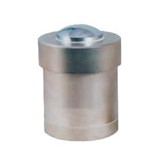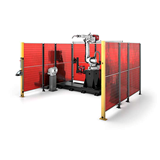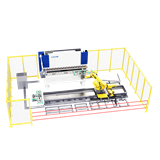Explore robotic welding cells in Australia. Compare types, costs, and compliance. Get insights for precision welding in your industry.
Key Takeaways
- Laser Types: There are different robotic welding systems based on the welding process, including MIG, TIG, and Stick welding robots.
- Price Range: Robotic welding cells in Australia range from $40,000 to $150,000+, depending on the capabilities, automation, and customisation.
- Operational Costs: Beyond purchase price, buyers should expect annual maintenance and consumable costs of $5,000 to $15,000.
- Financing: Financing options cover up to 100% of the purchase price, with interest rates ranging from 5% to 10%.
- Compliance: Machines must comply with Australian standards like AS/NZS 4024 and work health and safety (WHS) regulations.
Introduction
Robotic welding cells enhance manufacturing by boosting speed, precision, and consistency. They are ideal for high-quality, high-volume production in industries like automotive, aerospace, and heavy machinery. For Australian buyers, choosing the right cell involves understanding types, pricing, costs, financing, maintenance, and compliance. This guide offers actionable insights to help you make a smart, long-term investment.
Key Considerations Before Buying a Robotic Welding Cell
Before purchasing a robotic welding cell, it's important to evaluate the factors that will influence the machine's efficiency and suitability for your specific application. Here are the key considerations:
1. Welding Process Requirements
- MIG Welding: Fast and versatile, ideal for general-purpose manufacturing, automotive assembly, and high-volume production.
- TIG Welding: Offers precision for thin materials, perfect for high-end automotive and aerospace industries requiring superior quality.
- Stick Welding: Best for outdoor work and heavy-duty applications in construction and mining sectors.
2. Payload Capacity
- Assess the weight and size of the parts you plan to weld. A lightweight robotic arm works for small parts, while larger robotic arms are necessary for heavy or bulky components.
3. Work Envelope and Reach
- Ensure the robotic arm's reach covers the entire work area, especially for parts with complex geometries. The arm's range and flexibility should fit your specific welding applications.
4. Automation Integration
- Look for systems that can integrate smoothly into your existing production line.
- Part Loading/Unloading: Does the system feature automatic part feeders or conveyors for efficient production flow?
- Compatibility: Check if the robot can work with your existing machinery, such as CNC machines or assembly lines.
5. Downtime and Efficiency
- Choose a robot known for its reliability and minimal downtime. Ensure you can access support and spare parts quickly.
Types of Robotic Welding Cells
When considering a robotic welding cell, understanding the different types and their features is essential. The main categories include:
MIG Welding Robots
- Description: MIG (Metal Inert Gas) robots are the most common type used in industrial welding. These robots are fast and versatile, designed for high-volume production.
- Best For: General manufacturing, automotive assembly lines, and other industries that require fast, continuous welding.
TIG Welding Robots
- Description: TIG (Tungsten Inert Gas) robots offer higher precision and control over the welding process, ideal for thin materials and intricate welds.
- Best For: Aerospace, high-end automotive, and industries requiring fine-quality welds.
Stick Welding Robots
- Description: Stick welding robots, also known as SMAW (Shielded Metal Arc Welding) robots, are suited for heavy-duty applications and are used in harsh environments.
- Best For: Outdoor work, heavy construction, and other high-strength welding applications.
Robotic Welding Cell Prices in Australia
Robotic welding cells vary significantly in price depending on their specifications, capabilities, and customisation. Here is a breakdown:
1. Entry-Level Machines
- Price: $40,000 - $70,000
- Description: Basic MIG robotic welding systems, suitable for small to medium-sized operations.
- Use Case: General manufacturing, light-duty work.
2. Mid-Range Machines
- Price: $70,000 - $120,000
- Description: Includes more advanced features like higher automation and integration with conveyors or other systems.
- Use Case: Industries requiring flexibility, such as automotive or machinery production.
3. High-End Machines
- Price: $120,000 - $150,000+
- Description: Custom-built systems for specialised applications like TIG welding for aerospace.
- Use Case: Precision-focused industries such as aerospace, medical, or high-end automotive.
Operational Costs and Maintenance
Beyond the purchase price, operational and maintenance costs are key to understanding the total cost of ownership. Here are the ongoing costs you can expect:
- Energy Consumption: Robotic welding cells can be energy-intensive. Expect monthly energy costs ranging from $200 to $500, depending on the frequency of use and energy efficiency.
- Maintenance: Regular maintenance is necessary to ensure the system runs optimally. Service contracts typically range from $2,000 to $5,000 annually, depending on the complexity of the system and frequency of use.
- Consumables: Consumables like welding wire, electrodes, tips, and shielding gas can add up to $1,000 to $3,000 annually.
Financing Options for Robotic Welding Cells
Many businesses opt for financing to spread the cost of purchasing a robotic welding cell. In Australia, financing options typically cover up to 100% of the purchase price, with interest rates ranging between 5% to 10% per year. Here are common financing options:
- Leasing: Leasing options allow you to rent the equipment over a fixed period, usually 3 to 5 years, with the option to purchase the machine at the end of the lease term.
- Hire Purchase: A hire purchase agreement gives you ownership of the robotic welding cell after completing the final payment. It offers flexibility for those who want to own the system outright.
- Bank Loans: Traditional bank loans are another option for financing robotic welding cells, typically offering lower interest rates but requiring a solid business plan and credit history.
Compliance and Certification Considerations in Australia
When purchasing a robotic welding cell in Australia, there are several compliance and certification requirements to keep in mind:
- Australian Standards (AS/NZS 4024): Robotic welding cells must adhere to strict safety standards to ensure they are safe for operation. These standards cover the design, construction, and operation of machinery.
- Workplace Health and Safety (WHS) Regulations: Employers must ensure that the system complies with WHS regulations, which govern the safe operation of machinery in Australian workplaces.
- Operator Certification: Operators must undergo certified training to operate robotic welding equipment safely. This training ensures they understand the machine's capabilities, limitations, and safety protocols.
Used vs. New Robotic Welding Cells
Experienced buyers often consider purchasing used systems to reduce initial costs. Here’s a comparison:
- New Systems: Offer the latest technology, warranties, and full manufacturer support. These systems are ideal for businesses looking for the highest levels of reliability and performance.
- Used Systems: Can offer substantial savings but may come with higher maintenance costs, limited warranty, and outdated technology. Used systems should be carefully inspected for wear and tear.
Common Questions from Robotic Welding Cell Buyers
Q1: What is the lifespan of a robotic welding cell?
Robotic welding cells typically last between 10 to 15 years with proper maintenance.
Q2: How often does a robotic welding system need maintenance?
Regular maintenance is recommended every 6 to 12 months, with more frequent checks during heavy usage.
Q3: Can I integrate a robotic welding cell with my existing production line?
Yes, many robotic welding cells can be integrated with existing systems, but you’ll need to ensure compatibility with your current equipment and workflows.
Q4: Are there any government incentives for purchasing robotic welding cells?
Some government grants or tax incentives are available for businesses investing in automation technologies, including robotic welding cells.
Conclusion
Purchasing a robotic welding cell in Australia is a significant investment that can boost productivity, precision, and safety. By considering factors like machine type, costs, compliance, and financing, you can make an informed decision that aligns with your business needs, ensuring long-term success.















